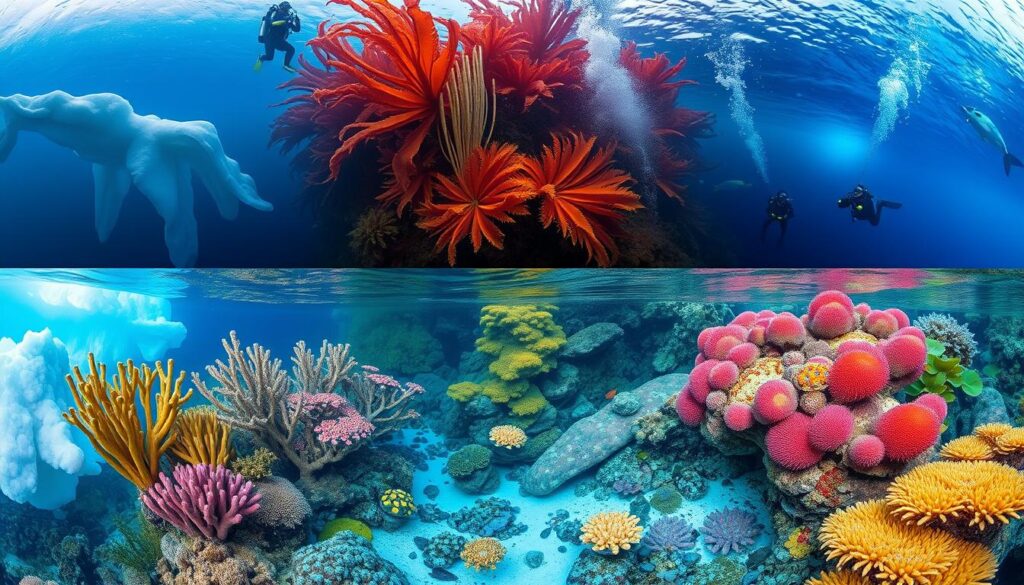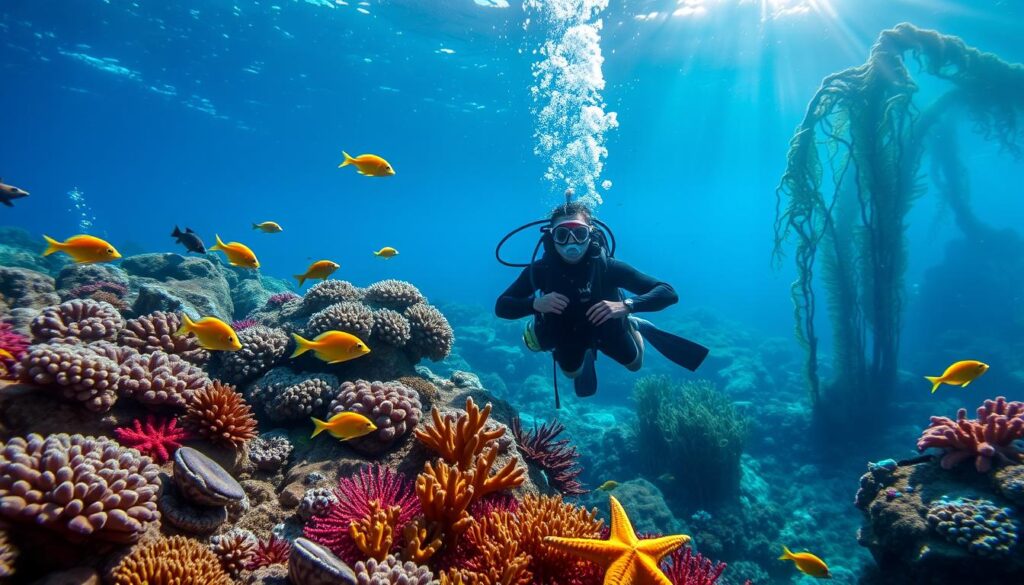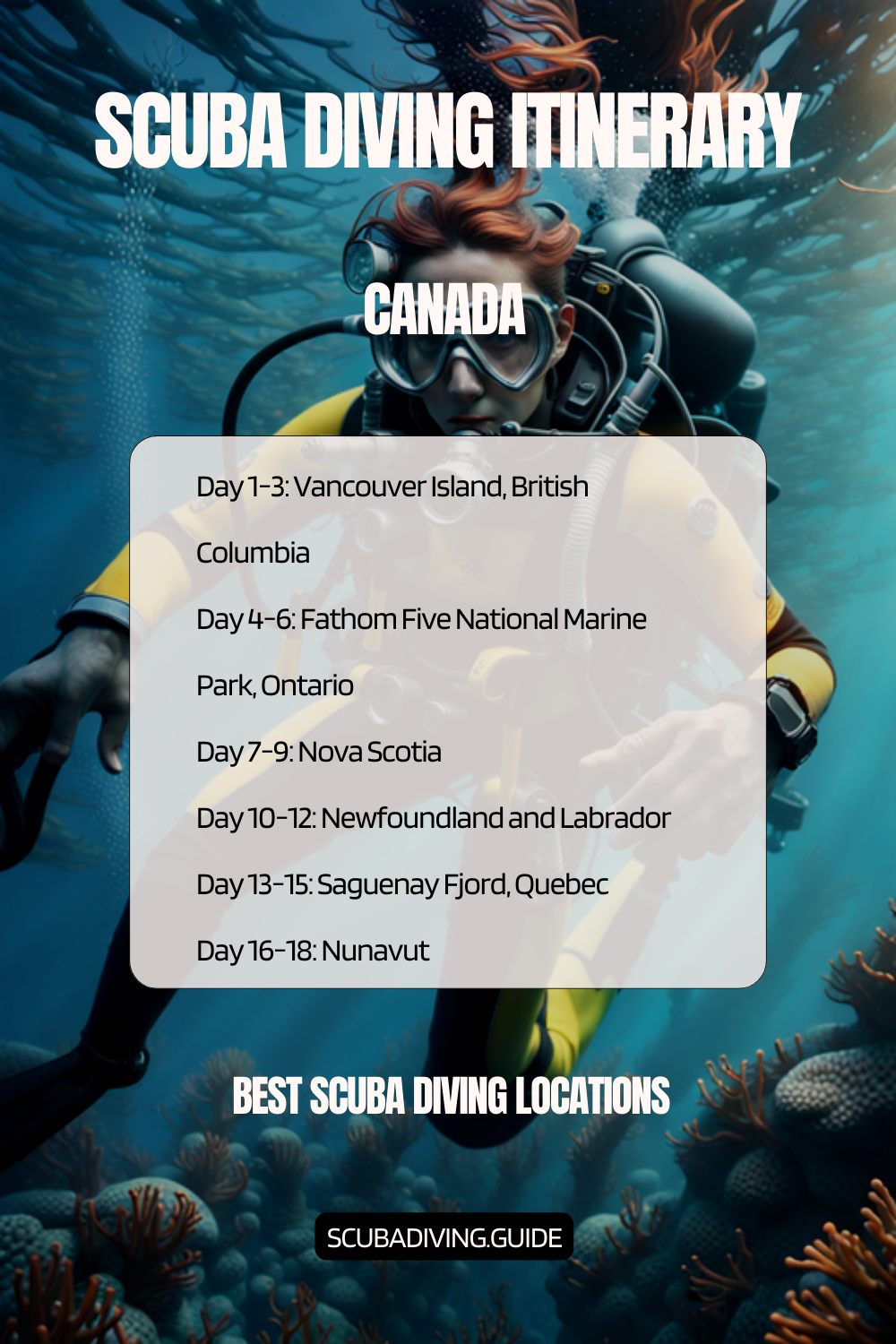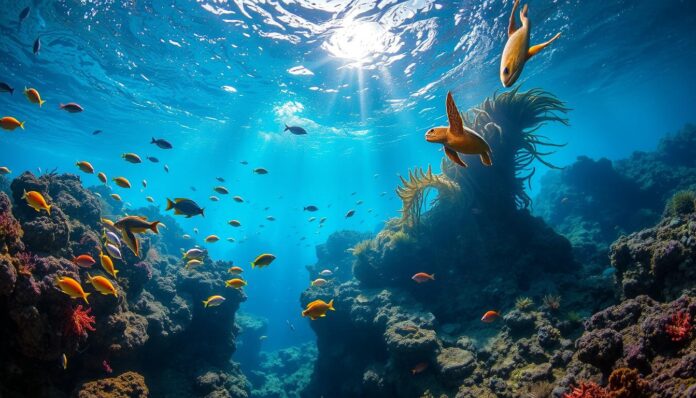| Best Time to Travel | May to October (summer) |
| What to Expect | Visibility of up to 60 feet, cool water (45-65°F), diverse marine life |
| Diving Conditions | Year-round diving, but best during the summer (warmer water, calmer seas) |
| Marine Life | Whale sharks, sea lions, seals, octopuses, crabs, lobsters, fish |
Are you ready to explore the most amazing underwater world? Canada has scuba diving that will blow your mind. From icy waters in British Columbia to historic shipwrecks in the Great Lakes, Canada’s underwater adventures are unforgettable.
Scuba diving in Canada is more than just a sport. It’s a journey through diverse and untouched marine environments. Whether you’re an experienced diver or just starting, Canada’s underwater world has secrets to share.
Canada isn’t just about cold waters. Divers can see vibrant marine life, meet unique creatures, and dive through landscapes from rocky coasts to shipwrecks. Each dive is a new story, each place a new challenge.
Key Takeaways – Scuba Diving in Canada
- Canada offers unique cold-water diving experiences across multiple provinces
- Drysuits are essential for navigating Canadian water temperatures
- Diverse marine environments include both saltwater and freshwater dive sites
- Vancouver Island and Lake Ontario provide world-class diving opportunities
- Professional certification is key for safe diving in tough conditions

Introduction to Scuba Diving in Canada
Canada is a treasure trove for scuba diving, with 435 unique dive sites along its coast. These sites offer a thrilling experience for those who love the sea. It’s a place where cold water diving meets adventure.
Diving in Canada is not for beginners. The water is usually cold, with temperatures rarely above 13°C. This requires special gear and careful planning. But for those who are up for the challenge, it’s a unique adventure.
“Scuba diving in Canada is less about tropical paradise and more about raw, untamed marine wilderness.” – Marine Exploration Magazine
- Diverse underwater ecosystems spanning three oceans
- Unique cold water marine environments
- Rich maritime history with numerous shipwrecks
- Incredible biodiversity
Canada’s diving spots are as varied as they are beautiful. From Vancouver’s rich Pacific waters to Newfoundland’s historic sites, each place offers a different dive experience.
| Diving Region | Unique Characteristics | Average Water Temperature |
|---|---|---|
| British Columbia | Kelp forests, diverse marine life | 8-12°C |
| Newfoundland | Shipwrecks, challenging currents | 4-10°C |
| St. Lawrence River | Freshwater diving, unique ecosystems | 5-15°C |
Preparation is key for Cold Water Diving in Canada. Specialized drysuits, advanced certifications, and proper training transform challenging conditions into extraordinary underwater journeys.
Best Scuba Diving Locations Across Canada
Canada is home to amazing dive sites for scuba diving. From the Pacific to the Atlantic, it has a wide range of marine environments. Each spot has its own underwater world and marine life to discover.
Let’s dive into some top diving spots in Canada. They show off the country’s underwater beauty:
Vancouver Island: A Diver’s Paradise
Vancouver Island is a top spot for scuba diving. Barkley Sound is known for:
- Pacific Octopus
- Sixgill sharks
- Diverse marine ecosystems
Here, divers find clear waters and a wide variety of marine life.
St. Lawrence River: Unique Freshwater Diving
The St. Lawrence River is great for freshwater diving. Brockville is a key spot with:
| Diving Highlight | Details |
|---|---|
| Wreck Quantity | 10+ shipwrecks |
| Depth Range | Up to 70 feet |
| Water Temperature | 20-23°C |
Bay of Fundy: Exploring Marine Life
The Bay of Fundy is another top spot for underwater exploration. It’s famous for its extreme tides and rich marine life. Divers can see unique species here.
“Canada’s underwater world is a hidden treasure waiting to be explored by adventurous divers.” – Marine Exploration Society
Each location offers a unique diving experience. Scuba lovers will find something special in Canada’s diverse marine environments.
What You Need to Know Before Diving
Getting ready for scuba diving in Canada needs careful planning. It’s important to know about certifications, equipment, and safety rules. This knowledge is key for a great underwater adventure.
Required Certifications and Training
Scuba Certification Canada is a must for diving. The Professional Association of Diving Instructors (PADI) offers courses that are recognized everywhere. Dive operators often ask for certification, which is more important for certain dives.
- Complete a recognized diving certification course
- Obtain a medical clearance before diving
- Understand local diving regulations
Recommended Diving Equipment for Canadian Waters
Choosing the right Diving Equipment Canada is vital for safe diving. Cold water needs special gear to keep you warm.
| Equipment | Purpose | Recommended Type |
|---|---|---|
| Wetsuit/Drysuit | Thermal Protection | 7mm Neoprene or Drysuit |
| Gloves | Hand Protection | Thick Neoprene |
| Hood | Head Insulation | 5mm Neoprene |
Safety Tips for New Divers
Always put safety first when diving. Follow these important tips for a safe dive:
- Always dive with a certified buddy
- Check equipment before entering water
- Monitor air supply constantly
- Ascend slowly to prevent decompression sickness
“Plan Your Dive, Dive Your Plan” – A fundamental rule for safe diving
Don’t forget about dive insurance. Most policies need proof of certification. Always invest in proper training and quality equipment for your safety.
Scuba Diving Season in Canada
Canada has amazing dive trips all year. With its long coastline, divers can see different marine life in each season.

Knowing when to dive is key. Each season in Canada brings its own underwater adventures. It’s perfect for those who love marine life.
Best Times to Dive Year-Round
The best time to dive in Canada is from June to September. During these months, the conditions are perfect in many places:
- Pacific Coast: June to September has the warmest water.
- Great Lakes: Late summer to early fall has the best visibility.
- Atlantic Provinces: Summer is the peak diving season here.
Seasonal Marine Life Changes
Marine life in Canada changes with the seasons. Winter diving in Vancouver is special:
- Winter has clear underwater views.
- Cooler water means less algae.
- There are more chances to see giant Pacific octopuses and other seasonal creatures.
“Winter diving in Canada offers a magical underwater world with crystal-clear views and unique marine encounters.”
Water temperatures vary a lot, from 46°F to 56°F (8°C to 13°C) on the Pacific coast. Divers need the right gear, like drysuits, in cold months.
Canada’s diving seasons have something for everyone. Whether you dive in the Pacific, Atlantic, or inland waters, there’s always something new to discover.
Marine Life You Can Encounter
Diving into Marine Life Canada opens up a world full of amazing creatures. Underwater Exploration Canada lets adventurers see some of the most varied marine places on Earth.
Exploring Canada’s Unique Ecosystems
Canada’s seas cover three oceans, making incredible underwater scenes. From British Columbia’s cold Pacific to the Atlantic coasts, divers find many different marine homes.
- Kelp forests along Vancouver Island
- Rocky underwater terrain in Newfoundland
- Cold-water coral gardens in the Atlantic
Common Fish and Invertebrates
The waters are full of interesting marine life that lives in cold places. Divers might see:
| Species | Unique Characteristics |
|---|---|
| Atlantic Wolffish | Males protect eggs for up to four months |
| Comb Jellies | Prevalent in Nova Scotia and New Brunswick waters |
| Northern Red Anemone | Carnivorous, feeds on tiny plankton |
Encountering Larger Species: Seals and Sharks
Bigger marine animals make unforgettable dives. Humpback whales migrate annually to Canadian waters, creating spectacular viewing opportunities. Sea lions and seals are common in coastal areas, making dives exciting.
“The ocean is a magnificent world waiting to be explored” – Marine Biologist
The Importance of Conservation
Keeping these delicate marine worlds safe needs careful diving. Canada’s wetlands are home to over a third of the country’s endangered species. This shows how important conservation is during underwater adventures.
Scuba Diving Tours and Operators
Planning your Dive Trips Canada needs the right dive operators. Scuba Diving in Canada offers unique underwater experiences. These demand professional guidance and expertise.
Choosing the perfect dive operator can make your underwater adventure amazing. Experienced divers know the right tour is key. It helps explore Canada’s magnificent marine landscapes.
Top-Rated Dive Shops Across Canada
Canada has many excellent dive shops. They are known for their quality service and local expertise:
- Action Scuba in Ontario
- Squba Holidays with 25 years of experience
- Dive shops in British Columbia specializing in Pacific coast expeditions
Guided Tours vs. Solo Diving
Different diving experiences fit different skill levels. Guided tours offer many benefits:
- Professional local knowledge
- Enhanced safety protocols
- Access to hard-to-reach dive sites
What to Expect from Professional Dive Operators
| Service | Typical Offerings |
|---|---|
| Pre-Dive Briefing | Comprehensive site and safety overview |
| Equipment Check | Thorough gear inspection |
| Emergency Procedures | Clear communication and preparation |
“Choose a dive operator who prioritizes safety and provides an unforgettable underwater experience.”
When picking your dive operator for Scuba Diving in Canada, think about group size, instructor qualifications, and local marine knowledge. This ensures an optimal diving adventure.
Underwater Photography Tips for Divers
Capturing Canada’s underwater world is more than diving. It needs special photography skills. These skills turn your dives into amazing photos.
Having the right diving gear is key for great underwater photos. The right equipment can turn a simple shot into a stunning marine image.
Essential Camera Gear for Underwater Shooting
- Waterproof camera housing
- External strobe lights
- Wide-angle lens
- Macro lens for close-up marine life
Best Practices for Capturing Marine Life
Photography in Canadian waters has its own challenges. The light and colors change a lot underwater. Colors like red, orange, and yellow fade first, so color correction is very important.
| Photography Technique | Recommended Action |
|---|---|
| Proximity to Subject | Stay within 12-18 inches for best detail |
| Lighting | Use external strobes to restore color |
| Buoyancy Control | Master neutral positioning |
“Water is 800 times denser than air – every inch closer matters in underwater photography.” – Professional Underwater Photographer
Pro tip: Practice in swimming pools before diving in open water. This helps you learn important skills without extra challenges.
Post-Processing Techniques
After taking your photos, edit them with software like Lightroom or Photoshop. Use it to improve colors, reduce backscatter, and highlight the vibrant marine life of Underwater Exploration Canada.
Environmental Considerations for Divers
Exploring Canada’s underwater world requires a deep commitment to protecting the environment. Scuba diving in Canada offers amazing experiences. But, it also comes with big responsibilities to marine ecosystems.

Every diver must work hard to protect our oceans. The underwater world is fragile and can be harmed by our actions. So, it’s vital to dive responsibly.
Protecting Marine Ecosystems
Divers are key in keeping our oceans healthy. Here are some important steps to reduce harm:
- Maintain proper buoyancy control to avoid damaging coral and marine habitats
- Never touch or remove marine life or artifacts
- Follow a strict “leave no trace” diving philosophy
“We are visitors in the underwater world, not conquerors.” – Marine Conservation Expert
Responsible Diving Practices
Using eco-friendly diving methods can greatly lessen harm to the environment. Here are some key guidelines:
| Practice | Environmental Impact |
|---|---|
| Avoid Touching Coral | Prevents physical damage to fragile ecosystems |
| Proper Waste Management | Reduces marine pollution |
| Minimal Sediment Disturbance | Protects marine habitat integrity |
Fact: Approximately 8 million metric tons of plastic enter oceans annually, making responsible diving more critical than ever.
By following these practices, divers can help keep Canada’s underwater beauty safe for the future.
Overcoming Common Diving Challenges
Scuba diving in Canada comes with its own set of challenges. Cold water environments need special knowledge and gear for a safe dive. This ensures a fun underwater adventure.
Divers in Canadian waters face several key challenges. These can affect their dive. Diving Equipment Canada helps manage these challenges.
Navigation Wisdom Underwater
Navigating Canada’s underwater landscapes is a skill:
- Master compass navigation techniques
- Learn natural navigation using underwater landmarks
- Practice maintaining orientation in low visibility conditions
“Preparation is the key to successful underwater navigation in challenging Canadian waters.”
Handling Equipment Issues
Cold water diving requires extra care with equipment. Scuba Diving in Canada means being ready for gear issues.
- Conduct thorough pre-dive equipment checks
- Understand cold water gear limitations
- Prepare for possible equipment malfunctions
Key challenges include managing dry suit performance, preventing regulator freezing, and maintaining proper buoyancy in challenging conditions.
Water temperatures around Vancouver Island can drop to 8°C to 10°C. This poses big challenges for equipment and comfort. But, with the right prep and knowledge, these challenges can become exciting.
Travel Tips for Divers Visiting Canada
Planning Dive Trips Canada needs careful thought. Scuba Diving in Canada is unique and requires good planning. From packing to choosing where to stay, divers need help to enjoy their underwater journey.
Packing Essentials for Your Diving Expedition
When getting ready for Dive Trips Canada, pack smart for different diving spots. Cold water diving needs special gear and careful planning.
- Thick neoprene wetsuit or drysuit
- Thermal undergarments
- Extra weight for buoyancy compensation
- Cold water regulators
- High-quality dive gloves and hood
Optimal Accommodation Strategies for Divers
Canada has great dive-friendly places near top diving spots. Where you stay can make your Scuba Diving in Canada better.
| Location | Accommodation Type | Diving Proximity |
|---|---|---|
| Tobermory | Dive Resorts | Immediate Access |
| Vancouver Island | Coastal Lodges | Close to Marine Parks |
| Thousand Islands | Waterfront Hotels | Near Multiple Dive Sites |
Think about how close you are to dive spots, where to store gear, and if you can rent equipment. Many places near great diving spots know what divers need.
“Preparation transforms a good diving trip into an extraordinary adventure.” – Professional Diving Instructor
Canada’s long coastline offers many diving spots. Look up local dive shops, know the rules, and always put safety first in your underwater adventures.
Highlighting Popular Dive Events and Festivals
Canada’s underwater world comes alive with exciting events all year. These events bring together divers, conservationists, and marine experts. They share knowledge and work to protect our oceans.
Dive Shows and Expos in Canada
The Canadian diving scene is buzzing with several notable events. Dive enthusiasts can find a range of conferences and exhibitions. These offer unique chances to learn and network.
- Canadian Underwater Conference and Exhibition
- Vancouver Island Dive Festival
- Great Lakes Diving Symposium
Annual Clean-Up Events
Conservation is a big part of Canada’s diving community. Clean-up initiatives show divers’ commitment to protecting marine ecosystems.
| Event Name | Location | Focus |
|---|---|---|
| Great Canadian Shoreline Cleanup | Nationwide | Coastal and underwater debris removal |
| Lake Superior Marine Conservation Dive | Ontario | Freshwater ecosystem protection |
| Pacific Coast Underwater Cleanup | British Columbia | Marine habitat preservation |
“Every dive is an opportunity to make a difference in our marine world.” – Canadian Marine Conservation Society
Joining these events supports marine conservation. It also connects divers with a community passionate about preserving Canada’s underwater environments.
From professional conferences to grassroots clean-up efforts, these events showcase Canada’s diving community. They highlight the community’s spirit and dedication to exploring and protecting our diverse underwater landscapes.
Scuba Diving for Beginners
Starting your scuba diving journey in Canada is exciting. Scuba Certification Canada offers many paths for beginners. Organizations like PADI have programs to help new divers become confident underwater explorers.
Getting diving equipment in Canada is easier for beginners. Dive shops offer rentals, making it affordable to start. You can find gear that fits your skill and budget. Courses include learning about your equipment and practicing in the water.
Introductory Courses and Programs
PADI courses in Canada are for all levels, from beginners to advanced. Programs like Discover Scuba Diving and Open Water Diver teach the basics. You’ll learn about buoyancy, managing your gear, and safety in a controlled setting.
Equipment Rentals and Options
Beginners can use flexible training options like the PADI Open Water Referral program. It lets you learn theory and some skills in one place, then finish elsewhere. With beginner packages, you can quickly become a confident diver.
Canada Recommended Scuba Diving Itinerary
To make the most of your scuba diving adventure in Canada, it’s helpful to plan a well-rounded itinerary that allows you to explore the country’s diverse underwater landscapes and marine ecosystems. Whether you’re diving in British Columbia’s coastal waters, the Atlantic provinces, or the freshwater lakes of Ontario, here’s a recommended scuba diving itinerary to guide you through some of Canada’s top diving destinations.
Day 1-3: Vancouver Island, British Columbia
Start your journey on the stunning Vancouver Island, where you’ll have the opportunity to explore some of British Columbia’s renowned diving sites. Begin with dives at Browning Wall, a spectacular wall covered in colorful marine life. Continue diving at God’s Pocket, known for its vibrant underwater ecosystems and encounters with marine mammals. Wrap up your time on Vancouver Island with a visit to the wreck of the HMCS Columbia, an impressive artificial reef teeming with marine life.
Day 4-6: Fathom Five National Marine Park, Ontario
Head to Ontario’s Fathom Five National Marine Park, located in Lake Huron near the town of Tobermory. Spend your days exploring the park’s shipwrecks, including the famous Sweepstakes and the City of Grand Rapids. These wrecks offer captivating underwater experiences, with abundant fish life and the chance to witness the transformation of wrecks into artificial reefs.
Day 7-9: Nova Scotia
Travel to Nova Scotia and embark on an adventure along the Atlantic coast. Begin your dives in the Bay of Fundy, where you can experience the incredible tidal currents and encounter a variety of marine life. Continue your journey with dives along the coast, exploring historic shipwrecks such as the SS Atlantic and diving in vibrant underwater environments teeming with fish, corals, and sponges.
Day 10-12: Newfoundland and Labrador
Make your way to Newfoundland and Labrador, known for its rich maritime history and remarkable diving opportunities. Dive along the coast of Bell Island, where you can explore well-preserved shipwrecks such as the SS Saganaga and the SS Lord Strathcona. These wrecks provide fascinating encounters with marine life and offer glimpses into the past.
Day 13-15: Saguenay Fjord, Quebec
Continue your Canadian diving adventure in the Saguenay Fjord, Quebec. Dive into the fjord’s deep, cold waters and marvel at its underwater cliffs and unique marine life. Explore the “Walls of Cap à l’Ouest,” where you can encounter curious seals and immerse yourself in the fjord’s captivating underwater landscapes.
Day 16-18: Nunavut
Conclude your Canadian scuba diving itinerary with an unforgettable Arctic diving experience in Nunavut. Dive among towering icebergs, explore the fascinating underwater canyons, and witness the incredible marine life that thrives in these extreme conditions. Encounter beluga whales, narwhals, and other Arctic marine species, creating memories that will last a lifetime.
Please note that this itinerary is a suggestion and can be customized based on your preferences, available time, and diving experience. It’s important to consider factors such as weather conditions, dive site accessibility, and travel logistics when planning your diving itinerary. Additionally, be sure to dive with certified operators, follow local regulations, and prioritize safety at all times.
With this recommended scuba diving itinerary, you’ll have the opportunity to explore the diverse underwater landscapes of Canada and encounter captivating marine life along the way. Each destination offers its own unique diving experiences, from colorful walls and wrecks to encounters with marine mammals and the wonders of the Arctic. Prepare for an adventure that will leave you with unforgettable memories and a deep appreciation for Canada’s remarkable underwater world.

Other Countries to Consider
FAQ – Scuba Diving in Canada
What certifications do I need to scuba dive in Canada?
To dive in Canada, you need an Open Water Diver certification from PADI, NAUI, or SSI. For cold water and tough dive sites, get Advanced Open Water or Dry Suit Diving. Dive operators want proof of recent dives and the right certification.
What’s the best time of year to go scuba diving in Canada?
Diving seasons change by region. Vancouver Island’s Pacific Coast dives all year, best in summer (June-September). The Atlantic Coast and inland waters dive best from late June to early September. Winter diving needs cold water gear and advanced skills.
What special equipment do I need for cold water diving in Canada?
For cold water diving, you need a dry suit or thick wetsuit, 7mm gloves, a hood, and thermal clothes. Use cold water regulators, thick boots, and heated undergarments. Most divers get a dry suit certification for this gear.
What marine life can I expect to see while diving in Canada?
Canadian waters have sea otters, seals, sea lions, salmon, lingcod, rockfish, and colorful nudibranchs. The Pacific Coast has kelp forests and marine mammals. The Atlantic has unique cold-water marine life. Seasonal migrations bring whales and other large marine species.
Are there any dangerous marine animals in Canadian waters?
Canadian waters are mostly safe, but be aware of marine mammals and some marine life. Seals are curious but not aggressive. Shark risks are low, with only a few species seen. Always keep a distance from marine life and follow local rules.
How much does scuba diving cost in Canada?
Diving costs vary by location and experience. A single dive costs $100-$250, with packages cheaper. Certification courses are $400-$600. Gear rental is $50-$100 a day, plus travel and accommodation costs. Cold water gear and dry suit certifications add extra expenses.
What are the most popular dive sites in Canada?
Top sites include Vancouver Island’s Browning Pass, St. Lawrence River shipwrecks, Bay of Fundy in Nova Scotia, Race Rocks near Victoria, and Brockville in Ontario. Each offers unique underwater experiences, from marine life to historic shipwrecks.
Do I need travel insurance for diving in Canada?
Yes, dive travel insurance is essential. Look for policies covering diving emergencies, equipment loss, and evacuation costs. Many travel insurance policies exclude diving, so make sure your policy includes diving activities.
How cold are the waters for diving in Canada?
Water temperatures vary by region and season. Pacific Coast waters are 7-15°C (45-59°F), while Atlantic waters are 4-10°C (39-50°F). Summer months are warmer, but dry suits and thermal protection are key for safe diving.
Are there any conservation efforts I can participate in while diving?
Many dive organizations in Canada have marine conservation programs. These include underwater clean-ups, marine life monitoring, and citizen science projects. Organizations like Ocean Wise and local dive shops often organize events for marine ecosystem preservation and research.
